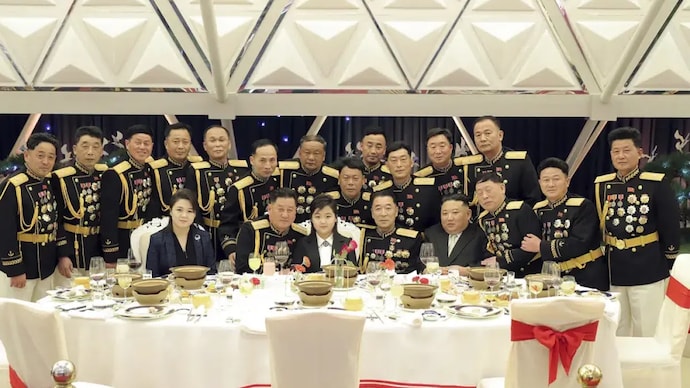
State media reported on Wednesday that North Korean leader Kim Jong Un praised the "irresistible might" of his nuclear-armed military while bringing his daughter to visit troops to commemorate the 75th anniversary of the country's army's founding.
Mr. Kim was expected to showcase the most recent hardware of his rapidly expanding nuclear weapons program, which stokes the concern of its neighbors and the United States, during a massive military parade that reportedly began Wednesday night in the capital, Pyongyang. The visit came before the parade.
Two officials from South Korea said that the parade probably started around 9 p.m., but they didn't go into further detail or say if Kim was there. Because they frequently feature newly developed weapons systems that the North intends to eventually test and deploy, North Korean military parades are closely watched by experts and governments outside the country.
Kim Ju Ae, Mr. Kim's daughter, sat next to him at a table and shook the hands of senior officials in her fourth known public appearance. She is thought to be 9 or 10 years old. Analysts contend that Mr. Kim's decision to bring his daughter to military-related public events serves as a reminder to the world that he will not voluntarily give up his nuclear weapons, which he reportedly regards as the strongest guarantee of his survival and the continuation of his dynastic rule.
Debate has also erupted regarding whether Kim Ju Ae is being primed as her father's successor due to the lofty descriptions of her by state media, such as "respected" and "beloved." In November, she went to a flight test of an intercontinental ballistic missile and has been with her father to a meeting with military scientists and a missile inspection.

On Wednesday, Mr. Kim and his daughter went to the general officers' lodgings, according to the official Korean Central News Agency of North Korea. Later, he gave troops an encouraging speech at a banquet, praising them for keeping the "strongest army in the world" despite difficulties from outside.
As he seeks to escalate an already provocative run of weapons demonstrations in the face of deepening tensions with his neighbors and Washington, the visit came a day after Mr. Kim presided over a meeting with his top military brass and called for an expansion of combat exercises aimed at sharpening war readiness.
Photos published by state media showed military officials applauding at the banquet, which appeared to have been held at the Yanggakdo Hotel in Pyongyang. Mr. Kim and his daughter, both wearing white dress shirts and black suits, held hands as they walked down a red carpet with Kim's wife, Ri Sol Ju.
In his speech, Mr. Kim said that being the supreme commander of an army that is "fulfilling (the) call of the times and history as the strongest army in the world" was his "greatest honour" and pleasure.
When Mr. Kim paid a visit to the troops, neither Washington nor Seoul were mentioned in any of the reports by state media. However, in an editorial published on Wednesday, the official Rodong Sinmun newspaper of Pyongyang stated that when confronted with threats from the enemy, the North's military is prepared to launch a "super strong strike of unimaginable might to wipe out the origins of provocations without a trace."

According to the newspaper, North Korea's increased weapons tests and combat exercises in the previous year were successful demonstrations of the country's "overwhelming military might" that support the government's escalatory nuclear doctrine and its policy of "power-to-power, all-out confrontation" with adversaries.
On the anniversary, people in Pyongyang went to the city's Mansu Hill to pay their respects to the statues of their late leaders, Kim Il Sung and Kim Jong Il, who were their ruler's grandfather and father, while soldiers lined up to salute them.
The plans for a parade have not been confirmed by state media in North Korea. However, commercial satellite images have revealed weeks of apparent preparations for the event, typically intended to honor Mr. Kim Jong Un's rule and his unrelenting efforts to establish the North as a nuclear power. These preparations appear to involve a large number of troops as well as civilians.
The costs of Mr. Kim's nuclear ambitions are mounting, as evidenced by North Korea's growing economic isolation and food shortages.
The dozens of missiles that North Korea fired in 2022 included potentially nuclear-capable systems designed to strike targets in South Korea and the U.S. mainland. This comes on the heels of a record-breaking year for weapons testing by North Korea.

Fiery statements threatening preemptive nuclear attacks against its neighbors and the United States in a wide range of scenarios in which it may perceive its leadership as under threat punctuated the intensified testing activity.
As Kim intensifies his nuclear push into 2023, animosity could grow in the months to come.
Mr. Kim called for an "exponential increase" of the country's nuclear warheads, mass production of battlefield tactical nukes targeting South Korea's "enemy," and the creation of more potent intercontinental ballistic missiles that could reach the continental United States at a major political conference in December.
In addition to conducting developmental tests, North Korea may increase the intensity of its military demonstrations in response to the expanding joint military exercises between the United States and South Korea, which the allies claim are meant to combat the North's growing threat.
As it deplored U.S. plans to expand its joint exercise with South Korea and deploy more advanced military assets to the region, including bombers and aircraft carriers, the North Korean Foreign Ministry issued a warning last week that the nation is prepared to counter U.S. military actions with the "most overwhelming nuclear force."

0 Comments